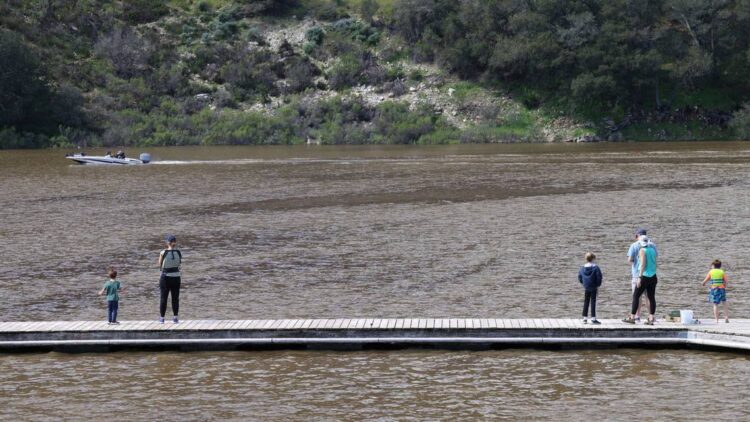Heavy rains from a series of atmospheric river storms have filled another San Luis Obispo County lake to the brink of spilling for the first time in more than two decades.
Lopez Lake near Arroyo Grande was at 92.6% capacity as of Friday afternoon, according to data from SLO County Public Works, a massive gain from where it was just three months ago.
As recently as Dec. 10, Lopez was at a mere 22% of capacity. On Jan. 1, it was at 24%.
Less than a week ago, however, the reservoir had improved to 66% filled.
The combination of multiple atmospheric rivers in January and March now have it nearly at capacity.
“It’s definitely going to spill,” San Luis Obispo County Public Works Department spokeswoman Paula McCambridge told The Tribune. “It’s the last of the (county-maintained) reservoirs to reach 100% capacity.”
McCambridge said because the reservoir continues to fill with runoff from the recent storm, the lake level is rising each day. If the region got no more rain, she said Public Works estimates Lake Lopez would spill in about eight days.
“Tuesday’s storm could be enough to put it over the top,” she said.
McCambridge said the last time the reservoir spilled was in 1999. In the lake’s more than five decades in operation, it has spilled 18 times in total, she added.
As of Friday afternoon, the water level at Lopez Lake was at 518 feet, while the spillway level is at 522 feet, according to Public Works.
The reservoir, which was established in 1968, can store a maximum of 49,388 acre-feet of water and contained 45,751 acre-feet of water as of Friday, according to the data. It is also used for recreational activities such as boating, camping, fishing and mountain biking and also provides water to residents of the Five Cities area of SLO County.

Public Works to monitor for flooding impacts from lake spilling
Although the lake hasn’t spilled in 24 years, McCambridge said Public Works has ensured that the condition of the spillway itself — which will direct the overflowing water into Arroyo Grande Creek — has been maintained through that time with regular maintenance and inspections.
“We want the public to know that the reservoirs aren’t something that come to our attention just in the case of heavy rains,” she said. “It’s our highest priority, public safety. So we don’t wait to react to situations.”
According to McCambridge, when the reservoir does spill, the Public Works Department will keep a close eye on stream gauges and perform on-site monitoring to watch out for potential flooding along the creek area.
“It is possible that there would be flooding,” she said. “If we have a high-impact storm, we are expecting a lot of water.”
Oceano in particular has already been at risk of flooding throughout this winter’s extreme storms thanks to its location near the Arroyo Grande Creek Levee. During recent storms, officials issued evacuation warnings and in some cases, orders, as water levels rose in the area.
McCambridge said if there is a need for an evacuation due to an extreme influx of water in the creek during the next storm, the county is prepared to issue orders immediately.
“We’ve got boots on the ground and people at their computers, and so at the earliest sign of information that the public needs to have, the public will have it,” she said.
Two other SLO County reservoirs already spilling
Lopez Lake would the the third local reservoir to reach capacity this winter.
Earlier this week, Whale Rock Reservoir near Cayucos spilled for the first time in 18 years.
The last time Whale Rock was close to capacity was in May 2019 when it reached 90%.
By the afternoon of March 11, the reservoir reached 111% capacity.
And Santa Margarita Lake has been overflowing into the Salinas River since Jan. 9.
It was at 105% of capacity as of Friday.
[ad_2]
Source link







